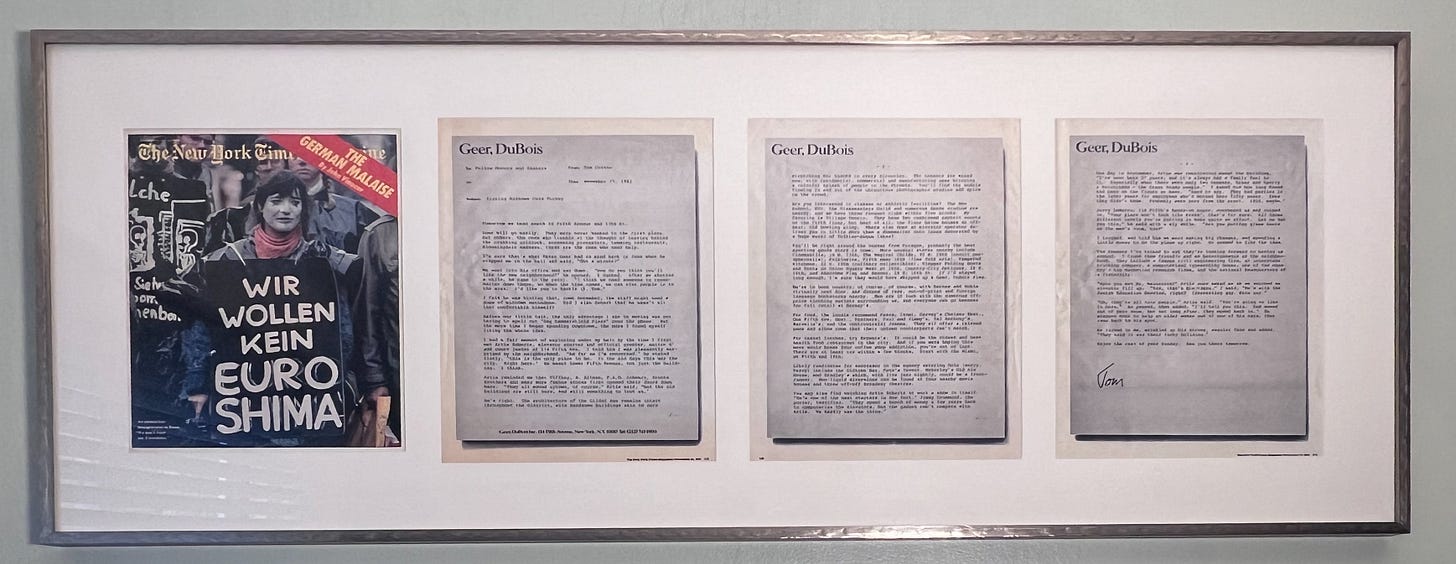Two years into the business, I get the scariest assignment of my career
When you're tapped to write an ad agency's own story, it better be good.
The ultimate test of an ad agency’s brand storytelling should be its own storytelling, right?
It’s like Thom Browne showing up at the Met Gala in his own suit.
No pressure or anything.
So imagine how I felt when my agency owner pulled me into his office for a top-secret project: write an ad about our upcoming office move to run in The New York Times.
Wait—me?!
I wasn’t a copywriter yet—just a green account guy.
But I was also a nobody, so he probably figured nobody would notice what I was up to.
The agency was Geer DuBois, nicknamed “The Bermuda Of Advertising” back then, and the owner was the debonair Peter Geer. I guess he’d noticed that I could produce a decent memo, and that was his idea: print an interoffice memo in the Times Sunday Magazine the day before our move into new lower Fifth Avenue offices.
*Gulp*
This was 1981—no digital previews yet—only Peter’s teaser memo to the staff on the Friday before the move so people would look for it on Sunday.
The ad became a three-page narrative, starting across from the Sunday crossword puzzle (the most coveted and pricey page in every issue.) This copy hangs behind my desk:
I had serious help
I wrote and signed the ad, but Peter’s editorial “support” through countless drafts was not only a huge help but a priceless writing tutorial. He had spent 4 years as David Ogilvy’s personal assistant before taking over the agency his parents founded just before WWII, and he was a gifted writer and creative leader.
What was the strategy here?
Peter needed to reassure his distinguished clientele that this move wasn’t a down-shift by a struggling agency for cheaper rent, but a gutsy demonstration of his business savvy and creativity. He also thought it would be an effective publicity stunt.
But the most important audience became the agency staff.
Geer DuBois was highly-respected with a deep bench of talent—from its Mad Men era leadership to the young guns who were driving the best creative work.
But the stability of good agencies’ talent pools is somewhere between fragile and fractured. And as Tom Peters put it in his seminal book, “In Search of Excellence,”
“The inventory goes down the elevator at night.”
And the “inventory” was souring on the move, and ripe for the picking by the competition.
Lower Fifth Avenue wasn’t “The Flatiron” yet—far from it
The relo wasn’t a good look: leave our swank midtown digs, high up in Dag Hammerskjold Plaza overlooking the East River, for 17th St. and Fifth Avenue—a nondescript “tweener” neighborhood between Chelsea and Greenwich Village.
More space for less rent, a custom build-out, and a 15-year lease was the attraction for Peter, but none of us thought it was cool, and it started raising a few eyebrows at Geer’s tony clients like IBM, EF Hutton, and Mercedes.
The assignment grows…
A month into my research and early drafts, as staff grumbling grew, Peter decided to romance the move by having me also write an employee guide to the neighborhood, including a history of its “Ladies Mile” retail legacy and a round-up of nearby food, bars, quirks and happenings.
It became a 22 page booklet illustrated by a brilliant young bullpen illustrator, Tom Kane:
Was it all worth it?
The PR was outstanding—lots of attention in the the ad trades and the general business press. (Coolest hit for me was Page Six in the NYPost!)
Staffers were surprised to find the neighborhood guide on their desks when they arrived Monday morning, and impressed by the prominence of the ad. And after their initial no-privacy shock—all offices had glass walls and doors—everyone took a shine to the office design.
Since my name and signature were on the memo, I was tracked down for a couple months by reporters, neighborhood establishments, and non-profits clamoring for our attention—those grateful to be called out in the ad, and a few who were miffed that I hadn’t included them.
Peter appeared pleased with the employee and client reactions. I remember colleagues being surprised by my role in it all, and a few jealous folks who resented my prominent role in it.
Mostly I remember being thrilled to have it behind me and to get my life and job back.
Disruptive, unexpected stories, told well.
In addition to the writing experience, I also appreciate what a great lesson it all was in the power of a distinctive, well-told brand story, appearing in an unexpected venue.
I’m still in the business of helping brands and businesses stand out and differentiate themselves while also hoping to surprise and delight their employees, customers and prospects. And whenever we can open peoples’ minds—and ultimately their wallets—that’s what it’s all about.
Geer DuBois’ heyday soon passed
A year later I was recruited by Backer & Spielvogel, and I was lucky to miss the agency’s slow decline in the late 80’s, and its painfully public death in the early 90’s.
The best part of my Geer DuBois story? Two lifelong friends and creative soulmates—Rob Janoff, and the late Doug Pippin—who I’ve been very lucky to share my life with.









Terrific story about the power of public relations when used creatively. Not surprising that you were picked for this assignment, Tom. I remember working at Backer & Spielvogel where everyone looked forward to reading your creatively written interoffice memos.